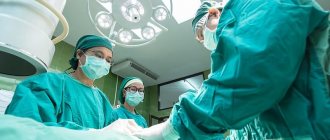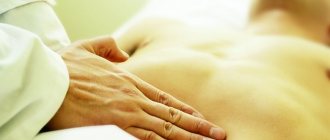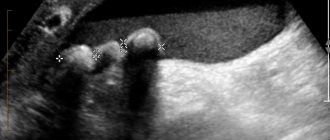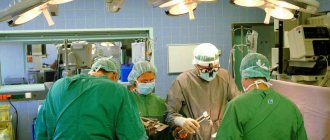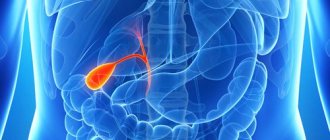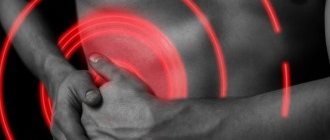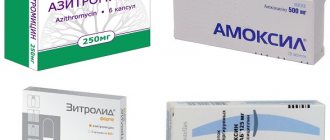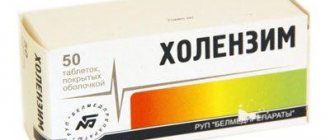Gallstone disease (gSD) and cholecystectomy (removal of the gallbladder) may recur. The body recovers gradually after surgery, and painful sensations in the right hypochondrium often appear. This condition is postcholicystectomy syndrome. To prevent it, drugs are prescribed to improve secretion: Drotaverine, Pirenzepine, Mebeverine and others.
What symptoms may appear after surgery:
- nausea;
- bloating;
- flatulence;
- stomach upset;
- colic in the liver;
- jaundice.
The main cause of pain and disorders of the gastrointestinal system is damage to the sphincter. It has important regulatory functions - it controls the movement of bile, stomach acid and prevents the migration of food particles into the duct from the small intestine.
After surgery, the intestinal microflora is disrupted; it is contraindicated to take antibiotics and other medications at this time, especially sedatives and blood pressure reducers. Colds and minor illnesses are best treated only with medications prescribed by your doctor. Incorrect self-medication can lead to relapse of cholelithiasis.
Yogurts and fermented milk products containing bifidobacteria and restoring motility of the gastrointestinal tract are indicated.
Medicines should be taken alternating between bile acid-based medications and medications that normalize peristalsis.
For constipation, lactulose disaccharides are prescribed. Diarrhea is stopped with drugs that remove toxins and antimicrobial agents.
If you experience frequent heartburn and pain in the subcostal area that lasts more than one hour, medications that neutralize acid are recommended. For nausea, you should drink Domperidone, enterosorbents with lignin, and activated carbon.
After the operation, the muscle tissue around the bile ducts in the passage through the walls of the duodenum is disrupted; the sphincter cannot influence the accumulation of bile, as a result of which food is not properly digested. Impaired metabolism leads to disruption of the supply of fats and nutrients. Dysbacteriosis and inflammation of the intestinal walls appear. Stagnation of bile leads to the formation of stones, which can often only be removed through surgery.
Medicines used after cholecystectomy
After removal of the gallbladder, problems with the functioning of the stomach are observed. Under normal conditions, bile that enters the duodenum increases the production of gastric juice. The disease and subsequent surgery entails a lack of bile. In order to improve intestinal function, they resort to:
- fermented preparations;
- antispasmodics;
- choleretic drugs;
- herbal medicines.

Medicines with enzymes
Fermented medicines are auxiliary means for insufficient bile volume. Mezim and Festal contain enzymes that help decompose proteins, carbohydrates, fats and are prescribed in the postoperative period for better absorption of nutrients from food. In addition to the main function, they can slightly relieve pain.
Thanks to the content of enzymes from the pancreas, Creon microcapsules normalize intestinal function. The unique formula of the drug allows it to be optimally distributed in the small intestine.
Gallbladder removed: what medications should be taken
Cholecystectomy, or, in other words, surgery to remove the gallbladder, is one of the most common surgical interventions in Russia. The postoperative and recovery periods, as a rule, are not complete without taking medications.
What medications will you need to take after gallbladder removal, as well as general information about cholecystectomy and other useful tips and recommendations, you will learn from this article.
Indications and progress of the operation
The gallbladder is a small sac that stores bile. At the right moment, bile is released into the small intestine for subsequent participation in the process of breaking down food.
The main indication for cholecystectomy is cholelithiasis. Stagnation of bile leads to the formation of stones, which may not manifest their existence in any way, but may manifest themselves with an attack of biliary colic.
A person who has had an attack of biliary colic at least once in his life will never forget this moment.
The fact is that the walls of the bladder, contracting, try to push the stone out, causing severe paroxysmal pain.
If a stone comes out and gets stuck in the bile duct, this is fraught with complications such as obstructive jaundice and acute cholecystitis. In severe cases, peritonitis may develop.
https://www.youtube.com/watch?v=4t9Hx-QO374
As has already become clear, people with cholelithiasis can be divided into two categories: those who are not bothered by this problem in any way, and those who are admitted to the hospital with a diagnosis of biliary colic or acute cholecystitis. Do you need to go under the knife if you are diagnosed with stones, the presence of which does not cause discomfort? Modern surgeons do not give a clear answer to this question.
It all depends on the size and number of stones, as well as on the duration of the disease. Experts still recommend resorting to cholecystectomy after observing asymptomatic cholelithiasis for 2 years, since there is a high risk of complications - bacterial infection and the development of chronic cholecystitis.
If you experience more than one of the following symptoms, be sure to see your doctor for an examination:
- bitterness in the mouth;
- pain in the hypochondrium on the right;
- nausea, possible vomiting;
- sleep disturbance;
- appetite disorder.
Cholecystectomy is performed using two methods:
- By making an incision in the anterior abdominal wall. As a rule, this method is used in emergency cases, due to the high risks of complications in the postoperative period.
- By laparoscopy. Several small punctures are made on the patient's body, through which the doctor, using special instruments and a camera, removes the gallbladder. This method is more often used in modern medicine, since it is more gentle, and the patient after such an operation will be able to go home within a couple of days.
Life without a gallbladder
Patients who are scheduled for cholecystectomy often panic: is it dangerous to completely remove the organ and will it be possible to live normally after this?
The body can easily do without the gallbladder, since this organ is not vital. Bile will still be produced by the liver, the difference is that in the absence of a storage device - the gallbladder, it will continuously flow into the intestines.
After some time, the amount of bile produced will decrease, the body will adapt to the changes and the digestion process will proceed without difficulty.
However, there are a number of restrictions, the observance of which is very important in the period after cholecystectomy:
- Diet. The digestion process changes significantly, so you need to help the gastrointestinal tract and not burden its work with the digestion of heavy food.
- Limitation of loads , especially in cases where surgery was carried out not using laparoscopy, but by cutting the abdominal wall.
- Taking medications . The doctor must prescribe a number of medications that will help the organs cope with the increased load and the patient to eliminate the unpleasant consequences after the operation.
Medicines after cholecystectomy
So, your gallbladder has been safely removed.
Now the body has a lot of work to do to rebuild the digestion process, and various drugs can help it with this, the purpose of which is to reduce the load on the gastrointestinal tract and alleviate symptoms associated with changes in organ functions. Treatment will begin immediately after the operation, while still in the hospital, and you will finish the course at home.
Remember: only a doctor should prescribe medications; do not self-medicate so as not to harm yourself.
The following are the medications you need to take after gallbladder removal:
- Antispasmodics, or painkillers. Patients who have undergone cholecystectomy often complain of pain in the right side. The reason lies in the fact that too much bile enters the bile ducts, resulting in their spasm. Antispasmodics will relieve pain by relaxing the smooth muscles of the gastrointestinal tract and bile will freely leave the ducts, rushing into the intestines. The well-known antispasmodic is “No-spa”. The drug is fast-acting: the pain will subside within 10-15 minutes after administration. Other agents with a similar effect: “Drotaverine”, “Buscopan”, “Duspatalin”, “Mebeverine”.
- Choleretic agents. They stimulate the active production of bile, have a beneficial effect on liver function, prevent the formation of congestion in the bile ducts, and prevent the formation of stones. The most famous drugs: “Allohol”, “Holosas”, “Cholenzim”.
- Enzymes. Thanks to them, food will be actively broken down, despite the fact that the amount and concentration of bile entering the intestines after removal of the gallbladder may not be enough for this. They have a slight analgesic effect. The most famous drugs of the group: “Mezim”, “Festal”, “Creon”. All of them contain enzymes and will help your body cope with the digestion process and avoid heaviness, nausea and excess gas formation after eating. These medications should be taken strictly as prescribed, as in case of overdose they can cause hologenic diarrhea.
- Hepatoprotectors. They are needed to protect and restore liver cells, prevent the re-formation of stones, and may also have a choleretic effect. This includes drugs such as: “Karsil”, “Essentiale”, “Ovesol”, “Ursofalk”, Ursosan”.
Drotaverine Buscopan Duspatalin Allohol Holosas Creon Carsil Ovesol
Problems with the intestines are the scourge of patients with gallbladder removal. Unfortunately, it is unlikely that these problems can be avoided: it is all due to an insufficient amount of enzymes that help better digestion of food.
Flatulence, bloating, diarrhea or constipation - diet and medications prescribed by your doctor will help you cope with this: Espumisan, Duphalac, Dimethicone and the like.
If cholecystectomy was preceded by an inflammatory process, an additional course of antibiotics is prescribed. The choice of drug and the duration of its use is determined solely by the attending physician.
Folk remedies
A combination of recipes from traditional medicine and a course of medications will help to significantly increase the effectiveness of the therapy. Healing infusions are made from dried herbs, which can be purchased at any pharmacy.
The use of such drugs should be agreed with your doctor, and also taking into account individual intolerance. Immortelle flowers, corn silk, milk thistle seeds, chicory, cudweed and other herbs have proven themselves well as choleretic agents.
Below are several recipes that will be useful as an aid during the recovery period after gallbladder removal.
- Infusion of birch leaves and buds. Take both ingredients in a 2:1 ratio, pour 250 ml of boiling water and leave to brew for 1 hour. Take the resulting infusion half a glass 4-5 times a day. It has a choleretic effect, helps the stomach function and speeds up metabolism.
- Infusion of milk thistle seeds. You will need 2 tbsp. seeds that need to be crushed to a powdery state. Pour 1/2 liter of water and boil over low heat until the initial volume of the infusion is reduced by half. The resulting liquid must be filtered and drunk every hour, a spoonful. This remedy will improve the functioning of the liver and bile ducts, and also has a mild choleretic effect.
- Corn infusion. Pour a glass of boiling water over 2 tablespoons of corn silks and simmer for half an hour under a closed lid. Strain the resulting liquid, pour it into a glass, and top it up with boiled water. Take half a glass per day.
Physical exercise
Heavy loads are extremely undesirable during the first 6-12 months after surgery. You should especially be wary of activities that place a lot of tension on your abdominal muscles. Failure to follow these recommendations may lead to the formation of a hernia and suture dehiscence.
But this does not mean that you just need to lie down and not move. Therapeutic gymnastics and simple physical exercises help speed up recovery by activating intra-abdominal circulation and stimulating the functioning of internal organs.
Swimming is also a great way to help your body recover. 2 months after cholecystectomy, you can already begin to get in shape by doing morning exercises and walking in the fresh air.
These types of activities will not only help you recover faster, but will also give you a lot of positive emotions, which is also important for a harmonious state in general.
Diet after cholecystectomy
To restore the functionality of the body and normal functioning of the gastrointestinal tract after surgery, you will certainly have to follow a strict diet.
Principles of therapeutic nutrition after cholecystectomy:
- Fractional meals - eat little by little, but often: 4-5 times a day, this way you will stimulate the production of bile, preventing it from stagnating.
- Be sure to watch how much you drink - ideally, at least 2-3 liters, not counting soups and broths. Make it a habit to drink a glass of water 20-30 minutes before meals - this way you will protect the intestinal walls from the action of bile.
- Forget about food that is too cold (ice cream, jellied meat, drinks from the refrigerator) - this causes vasospasm in the digestive tract. All food and drinks consumed should be at room temperature.
- Avoid anything fried – such food irritates the walls of the stomach and intestinal mucosa. Prepare dishes in a double boiler, boil or stew in water.
What foods should be completely eliminated from the diet:
- Sausages, smoked products;
- Spicy, sour, pickled, salty foods, canned food, onions, garlic, radishes, turnips;
- Sweets, baked goods;
- Products containing a large amount of fiber and coarse fiber: bran, whole grain bread, legumes;
- Meat, poultry and fatty fish.
Soups should be cooked in vegetable broth, with the addition of cereals; milk soups are also allowed. For the second course, prepare boiled vegetables or cereals. For breakfast you can eat various porridges with milk or water, cheesecakes, casseroles, and omelettes.
Be sure to enrich your diet with fats: vegetable oils, butter in small doses. Fruits will perfectly satisfy your sweet tooth: pears, apples, bananas, sour fruits should be excluded. Marshmallows, marshmallows and honey are also allowed. You will have to adhere to a strict diet for at least a year, but it is better to avoid fatty and fried foods forever.
The condition of the body and the speed of its recovery after surgery depend largely on the patient himself. Proper nutrition, moderate exercise and timely intake of medications prescribed by your doctor will speed up your recovery and bring you back to your normal active life.
Removing the gallbladder is not a death sentence, but it is an excellent reason to start monitoring your health and listening to your body’s signals.
There are contraindications. Consultation with a specialist is required before use
© 2020 – 2020, MedPechen.ru. All rights reserved.
Source: https://MedPechen.ru/udalen-zhelchnyj-puzyr-lekarstva.html
Antispasmodics
No-spa is a strong antispasmodic. The main beneficial property is relaxation of the smooth muscles of the sphincter. The medicine enters the blood ten minutes after administration and relieves antispasmodic pain in the bile duct that occurs when liquid secretions enter the intestines. An intramuscular injection of No-shpa works faster than tablets.
Smooth muscles are relaxed by Mebeverine and Duspatalin. Providing a myotropic effect, they relieve spasms, stomach discomfort and colic. They act 20 minutes after administration and have virtually no side effects.
Choleretic medications
Choleretic drugs are prescribed to patients after cholecystectomy to protect the liver from stagnation of secretions and prevent inflammatory processes. Spicy and fatty foods are contraindicated for cholelithiasis. Natural remedies Allohol and Cholenzym promote the absorption of beneficial microelements from food and prevent upset and bloating.

Allochol increases the volume of bile produced by the liver and reduces the risk of re-formation of stones. Consists of pig bile, activated carbon, garlic and nettle extracts. Thanks to the presence of activated carbon, it neutralizes toxins in the intestines and interferes with metabolism.
Cholenzym is a complex that includes: an enzyme from dried animal pancreatic glands, it is natural and promotes the breakdown of food during heaviness and constipation.
For cholecystectomy, an effective herbal remedy is holosas based on rose hips. A sugary-sweet medicine, containing large quantities of flavonoids, pectin, acids, vitamins and essential oils, has an anti-inflammatory effect, improves the production of bile and stabilizes its transport through the liver ducts.
What medications should you take if your gallbladder has been removed?
Surgical intervention - removal of the gallbladder, is most often performed by doctors for special indications. For example, due to the shutdown of an organ in which the bile duct is blocked by stones.
However, the improper functioning of the biliary structures in the hepatocellular zone persists. Therefore, if the gallbladder is removed, what medications should be taken is decided by the attending physician.
When is medication required?
Of course, the gallbladder is a necessary organ that is designed to accumulate a supply of bile. However, for various reasons it has to be surgically removed. Sometimes to save a person's life.
The cholecystectomy operation itself does not cause difficulties for doctors. Whereas the absence of an organ certainly affects the functioning of the digestive tract. Various disorders appear:
- inflammation in the bile ducts;
- deterioration of food absorption;
- frequent exacerbations of gastritis with duodenitis;
- dyspeptic disorders.
Taking various subgroups of medications helps eliminate unpleasant symptoms - heaviness in the stomach, flatulence and stool disturbances during the postoperative recovery period. The optimal treatment regimen will be selected by a gastroenterologist taking into account the clinical picture of the disease.
Main subgroups of drugs:
- to relieve pain - antispasmodics;
- to improve intestinal motility - prokinetics;
- to restore the digestive process - enzymes;
- to correct the functioning of hepatocytes - hepatoprotectors.
It is unacceptable to take medications on your own, since you can provoke a deterioration in your health and transform an acute digestive disorder into a chronic pathological process.
Choleretic agents
A question often asked to doctors by people who have undergone surgery is what medications to take after removal of the gallbladder - are choleretic drugs acceptable or should they be abandoned.
Since the main purpose of such drugs is to prevent congestion in the hepatic ducts, it is quite acceptable to take such drugs in schemes to restore full digestion after surgery.
Thus, Cholenzym, a complex medicine based on animal components in combination with dry bile, is effective and popular.
It gently stimulates the synthesis of bile compounds, while simultaneously correcting its flow through the bile ducts.
In addition, the enzymes that are present in the medicine help accelerate the breakdown of foods - people who take it do not experience unpleasant heaviness after eating, as well as flatulence with constipation.
A herbal complex that successfully combines anti-inflammatory and choleretic effects is the medicine Holosas.
It has proven itself to be effective against congestion in hepatocytes and hepatic ducts - bile motility improves, it flows more smoothly into the intestinal loops.
At the same time, if the medicine is taken in a timely manner, the activity of the pancreas is corrected, the smooth muscles of all parts of the gastrointestinal tract relax.
Ursodeoxyfolic acid helps prevent relapse of stone formation in the bile ducts. It is present in the drugs Ursofalk or Ursosan. Doctors recommend taking them in courses to protect the organ from the negative effects of bile acids.
Antibacterial agents
Antibacterial drugs are often associated with gallbladder removal. Especially in situations where the intervention was carried out for emergency reasons and infectious processes were observed in the organ.
As a rule, antibiotics with a wide spectrum of antibacterial activity help suppress inflammatory foci. Surgeons prefer representatives of the subgroup of cephalosporins - Ceftriaxone, Cefotaxime or Cefdiroten.
Drugs are administered by intramuscular injection, which prevents an increase in the load on hepatocytes. In this case, both bacteriostatic and bactericidal effects on pathogenic microflora in the outbreak are observed.
However, if a preliminary assessment of the susceptibility of microorganisms to antibacterial agents is required, then a specialist will prescribe bile sampling to the tank. sowing. Then an antibacterial regimen is purposefully selected.
Self-medication with antibacterial drugs is unacceptable; they should be taken only as directed by a doctor. After all, a person may experience individual intolerance to certain subgroups of such medications or severe allergic reactions to the drugs. All this will aggravate the situation with postcholecystectomy syndrome.
Enterosorbents
To eliminate intoxication, which almost always accompanies the recovery period with removal of the gallbladder, there is a need to take enterosorbents, including those with lignin. After all, the speed of digestive processes decreases, food stagnates and begins to release toxins.
On the pharmacy shelf a subgroup of products is presented:
- Polyphepan;
- Polyfan;
- Entegnin;
- Lignosorb;
- Filtrum – STI;
- Lactofiltrum.
Their pharmacological activity is interconnected with the ability to retain many toxic, secondary substances on their porous surface, and then remove them from the intestine to the outside. If you take enterosorbents as a course, then the human body, which has undergone removal of a bladder with gallstones, gets the opportunity to recover better, without poisoning with toxins and various wastes.
Hepatoprotectors
Hepatoprotectors are prescribed against the reappearance of choleretic duct stones. They, along with bioactive lecithin preparations and polyunsaturated fatty acids, give positive dynamics during postoperative treatment. They have a good effect on the general condition of the body, have antispasmodic and choleretic effects, and protect the liver.
Hepatoprotectors contain herbs that relieve antispasmodic pain, dilute bile and reduce the risk of new stones.
Karsil and Essentiale Forte
Common hepatoprotectors are Carsil or Essentiale Forte. The drug Karsil is made on the basis of Milk Thistle extract, tones the liver cells, neutralizes toxic substances and improves bile production. With constant use, the medicine relaxes the sphincters, normalizes metabolism and digestion. Prevention of urolithiasis and rehabilitation therapy after surgery are also accompanied by taking Karsil.

Essentiale is a drug of chemical origin, has a much broader effect and has a higher degree of absorption. Essentiale is prescribed if there is:
- inflammatory liver diseases;
- chronic disorders of bile formation;
- irradiation.
Hepatoprotectors based on ursodeoxycholic acid
Common medications used after gallbladder removal are medications containing ursodeoxycholic acid, which dissolves gallstones and lowers cholesterol levels. The acid enhances the excretion of bile and prevents its stagnation. Ursodeoxycholic acid contains Ursofalk, Urdoxa, Ursosan, Livodexa.
Tablets based on ursodeoxycholic acid stimulate the secretion and renewal of T-lymphocytes. The substance has contraindications; its use is unacceptable for acute intestinal inflammation and certain types of cholelithiasis, as well as if a person abuses alcohol. Only a qualified doctor can prescribe acid after a thorough examination.
Urdoxa enhances the excretion of formed bile, reduces cholesterol and strengthens the body, helps to liquefy small formations of liver secretion every day and prevents the appearance of new stones.
Ursofalk has properties similar to Urdoxa. It acts better and more widely, penetrates liver cells and restores cellular metabolism.
Take Ursofalk once a day. The medication rarely has side effects other than minor upset. The use of Ursofalk is contraindicated in case of renal and liver failure and the presence of stones with a high calcium content.
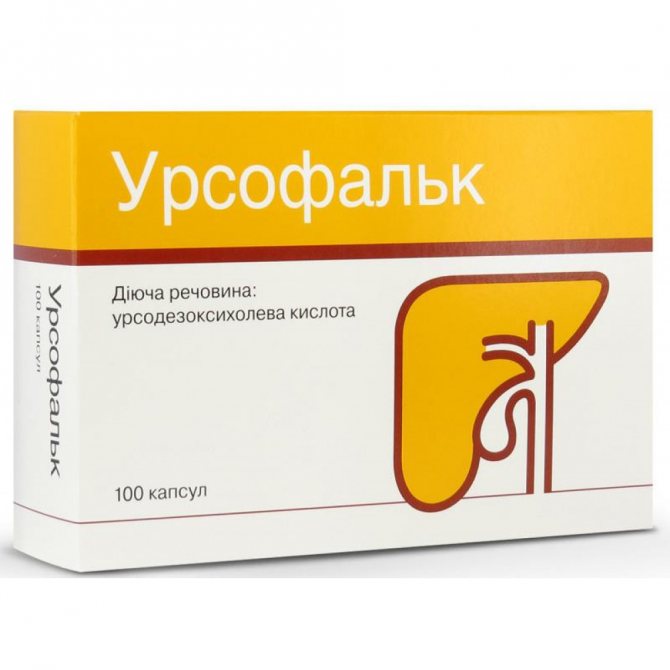
Gallbladder removed: what medications to take
The gallbladder plays an important role in the body, but you can live without it by following a diet and taking medications designed to restore digestion.
Removal surgery is performed when the organ fails to perform its function due to inflammation or overcrowding with stones.
The doctor will determine what medications to take after gallbladder removal depending on the patient's health condition.
Consequences of gallbladder removal
Bile is produced in the liver, then enters the gallbladder, which is a reservoir for it. The organ accumulates secretion and releases it into the duodenum when food enters there. If there is no reservoir for bile, it is discharged from the liver through the ducts into the intestines.
Bile can be present there even without the presence of food. The function of the missing organ is partially carried out by the bile ducts, but the secretion does not stay there for long. Medicines that need to be taken after gallbladder removal help regulate the production and secretion of bile.
Cholecystectomy is usually performed when an organ does not perform its function completely or partially. The digestive system has time to adapt to “switching off” the bladder from processes in the body. The liver begins to produce bile in lower concentrations.
In order for the secretion to be released into the intestines not constantly, but at a certain time, it is necessary to eat by the hour. This is how a reflex is developed.
In addition, special medications after removal of the gallbladder normalize the composition and regularity of bile release.
Removal is necessary so that the diseased organ does not cause inflammation and intoxication of the body.
Both when the organ does not perform its function, and in the period after removal of the gallbladder, unpleasant consequences associated with digestion are possible:
- bowel disorders (constipation, diarrhea);
- increased gas formation;
- belching;
- yellowness of the skin due to excessive secretion of bile.
Nausea, vomiting, and heartburn may occur due to excess bile entering the stomach. However, these symptoms often indicate gastritis of the stomach, which is caused by the Helicobacter microbe, so before prescribing drugs, an accurate diagnosis must be established.
Unpleasant phenomena are called “postcholecystectomy syndrome.” The doctor must decide what medications a patient should take after gallbladder removal, depending on the nature of the digestive problems.
He prescribes drugs that improve the breakdown of food and help restore the gastrointestinal tract after surgery, courses of antibiotics and other medications. Therapy continues for at least 6 months after surgery.
Some drugs to improve the functioning of the liver and intestines must be taken for life in courses of several months.
Enzymes
These drugs restore the digestive process, which may be disrupted after surgery. Additionally, pancreatic enzymes entering the body help to efficiently digest and assimilate food. Tablets containing amylase, lipase and lactase facilitate the functioning of organs after removal of the gallbladder.
Enzyme preparations include the following medications:
- Pancreatin;
- Creon;
- Festal;
- Micrasim;
- Mezim.
Festal Mezim
Antispasmodics
These medications facilitate the flow of secretions into the intestines and relieve spasms of the biliary tract. They are taken regularly or symptomatically when pain occurs. During an attack, the effect of the drug occurs after about 20 minutes.
Postoperative drug therapy includes taking one of the following:
- Drotaverine;
- No-shpa;
- Buscopan;
- Riabal;
- Spasmalgon;
- Duspatalin;
- Mebeverine.
No-shpa Drotaverine
Choleretic drugs
When a patient's gallbladder has been removed, medications to stimulate the release of bile are necessary in order to prevent the appearance of stones. Despite the absence of a bubble, stones can form and get stuck in the bile ducts. After meals, you can take medications containing bile to increase its concentration.
They promote easy flow of bile into the intestines. The most commonly used agents are Allochol, Cholenzym and Holosas. These drugs have a choleretic effect, so they are used to prevent the formation of stones and improve the flow of bile.
Allohol
A natural product containing dried bovine bile (70%), extracts of garlic and nettle. The composition contains activated carbon (10%) as a sorbent, which destroys bacteria in the intestines, prevents rotting and fermentation of undigested food. Allohol is taken after meals.
It has a complex effect:
- improves liver function;
- increases the secretion and outflow of bile;
- stimulates intestinal function;
- relieves flatulence.
Holenzym
Like Allochol, the drug contains dry bile and mucous membranes of animals; it must be taken after meals. Promotes better breakdown of food and increased production of your own bile. Cholenzym helps get rid of bloating, heaviness in the stomach, and cope with stool disorders.
Holosas
Herbal preparation in the form of syrup based on rosehip extract. It has a pleasant sweet taste and is taken before meals. In addition to the choleretic effect, it has an anti-inflammatory effect, supplies the liver with useful substances - flavonoids, vitamins, pectin. Rosehip is rich in natural acids and essential oils that dilute bile.
Karsil
The most common hepatoprotector, the main substance of which is milk thistle extract. It has a complex effect - improves the functioning of the liver, urinary system, and digestive tract. Karsil also has antitoxic and antiviral effects and normalizes the composition of bile.
Urdoxa
The drug is based on ursodeoxycholic acid, a substance that enhances the secretion of bile, dissolving cholesterol and stones in the ducts. The acid also increases the renewal of T-lymphocytes in the blood, thereby increasing immunity. Contraindications to taking the drug are alcohol abuse and acute intestinal inflammation.
Ursofalk
Like Urdoxa, this medicine is based on ursodeoxycholic acid. These two drugs have exactly the same effect on the liver and bile ducts, but Ursofalk has a wider spectrum. You need to drink acid for faster renewal of liver cells.


